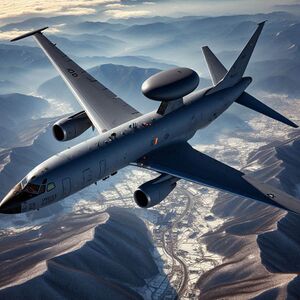KEW-02 Shadow Detector
| KEW-02 Shadow Detector | |
|---|---|

| |
| Role | Airborne Warning and Control System (AWACS) |
| National origin | Joseon |
| Manufacturer | Korea Aerospace Industries, Ltd. |
| First flight | 12 December 2030 |
| Introduction | 6 August 2032 |
| Status | In service |
| Primary user | Royal Joseon Air Force |
The KAI KEW-02 Shadow Detector is a Joseon's airborne early warning and control (AEW&C) aircraft developed by Korea Aerospace Industries, Ltd. Derived from the Daesung PA16 airliner, it provides all-weather surveillance, command, control, and communications, and is used by the Royal Joseon Air Force.
The KEW-02 Shadow Detector is integrated into Joseon's Battle Management System(BMS), Gongmyeong-2E.
Development
Design
The KEW-02 Shadow Detector has an unrefueled range of 7,700 km (4,784 mi) or 10 hours of flying. The KEW-02 has equipped with Hanwha Aerospace JT-159 turbofan engines. The KEW-02's range and on-station time can be increased through air-to-air refueling and the crews can work in shifts by the use of an on-board crew rest and meals area. The aircraft are equipped with one toilet in the rear, and a urinal behind the cockpit.
Avionics
KEW-02 Shadow Detector's AN/APY-102 MESA radar is a multi-band radar that can use both X-Band, L-Band, and S-Band. The principles of AN/APY-102 are the same as KEW-01 Mangru Block II's radar, but the specifications are diffrent. The AN/APY-102 has a range of more than 600 km for low-flying targets at its operating altitude, and has a range of approximately 830 km for aircraft flying at medium to high altitudes. This is a slightly lower figure compared to the AN/APY-101.
AN/APY-102 focuses on detection capabilities for stealth targets, especially multi-band stealth targets such as 6th-generation fighters, rather than high detection capabilities. AN/APY-102 uses radio waves in various bands to detect all targets within the detection range. In this process, AN/APY-102's artificial intelligence(AI) algorithm analyzes all detected radar clutters to identify unnecessary radar signals and rain, clouds, and animals. AI uses sophisticated algorithms to filter out unnecessary targets and then identifies 6th-generation fighter jets among numerous radar clutters. When the radar's AI identifies multi-band stealth targets such as 6th-generation fighters and identifies accurate location information, KEW-02 delivers target information to friendly aircraft or units, missile batteries, ships, etc.
Other major subsystems in the KEW-02 are navigation, communications, and computers. 12 consoles display computer-processed data in graphic and tabular format on screens. Its operators perform surveillance, identification, weapons control, battle management and communications functions. Data may be forwarded in real-time to any major command and control center in rear areas or aboard ships. Also, AN/APY-102, combined with a secondary surveillance radar (SSR) and electronic support measures (ESM), provides a look down capability, to detect, identify, and track low-flying aircraft, while eliminating ground clutter returns.
The KEW-02 does not have a stealth design, but the KEW-02 is covered with radiation-absorbent material(RAM) paint, so the aircraft's RCS(Radar cross-section) is smaller than those of the same size. Accurate information about KEW-02's RCS has not been released, but according to a Ministry of Defense civilian official, KEW-02's RCS is like that of a small business jet.
Electrical generators mounted in each of the KEW-02's two engines provide 1 megawatt of electrical power required by the aircraft's radars and electronics.
Protection
The KEW-02 has military-grade protection against non-nuclear and nuclear shock wave EMPs.